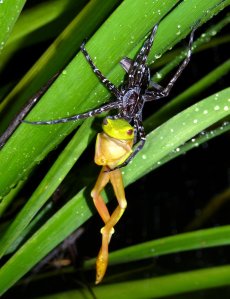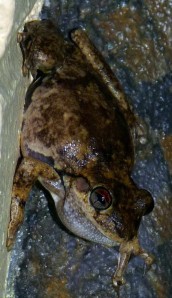The arrival of wet season rains is a time of renewal – the wetlands are replenished, the frogs breed and provide food for many other creatures. We find the sound and smell of the rain itself as well as the deafening cacophony of frog calls exciting ……. last night we had a look in the pond adjacent to our verandah.
A water spider, Pisauridae species of the genus Dolomedes, had captured a Graceful Tree-frog (Litoria gracilenta), one of many calling around the pond. According to Arachne.org.au “As Australian Pisaurids are being revised by Robert Raven at Queensland Museum, until this review is complete it will be difficult to correctly identify many Dolomedes species”

 One of the laughing frogs (Litoria rothii) wasn’t indulging in such risky behaviour and had camouflaged itself quite well against our house python. (House python is made of concrete covered wire and twines up a verandah pillar)
One of the laughing frogs (Litoria rothii) wasn’t indulging in such risky behaviour and had camouflaged itself quite well against our house python. (House python is made of concrete covered wire and twines up a verandah pillar)
In the car-port a white-lipped green tree-frog (Litoria infrafrenata) was hanging onto our vehicle while numerous sedge frogs (Litoria bicolour, Litoria fallax) called and jumped around the house; several had to be taken outside again after they found their way inside.
This morning we had a look for the remains of the spider’s meal; it was dragged up onto one of the rocks surrounding the pool – a somewhat gruesome sight softened by the flower petal decoration; exactly as found.
And so the circle of life continues – frog eggs (probably L. gracilenta) on the water below the frog corpse.





A brilliant finish to an unusual story.
Denis
Thanks Denis, it was fascinating to see the spider holding the frog. I am amazed that it had the strength to pull the frog’s body up onto the rock.
Cheers
Barbara
That’s amazing! I’ve seen barking spiders (Selenocosmia/Selenotypus) feeding on small frogs (they squeeze them into a neat little package), but that’s an impressive effort from the water spider. How wonderful to see it. Thank you for photographing it.
Thanks Bronwen. The following night the spider was holding the frog corpse from a leaf and continuing its meal. The next morning there was no evidence of the frog remaining and the spider was looking very well fed!
Hi – yeah it’s Martha from fire ridden Victoria. Trying to picture the pond. Is it the pool? Would love to come north and see you guys.
Hey Martha – great to hear from you. No, its not the pool, although it could have been as it is now a freshwater pool which functions as a habitat as well as a cooling off pool. No the spider was in the little ornamental pond against the verandah. I’ve been looking at the extent of the fires on incident alert – they’re so scary, are you still at Selby?
Dear Barbara,
May I introduce myself to you. My name is Martin Nyffeler and I am an arachnologist affiliated with the University of Basel, Switzerland. I am currently preparing a scientific paper on frog- and toad-eating spiders, which I intend publishing in an international scientific journal.
The reason why I am contacting you is as follows. While searching for pictures of frog-eating spiders in the internet, I came across your photos of a fishing spider that is feeding on a graceful tree-frog. I wish to ask you for a huge favor. Would you please give me permission to use your photos in my new publication? It would be great if you would send me high-resolution copies. Of course I would give you full credit for being the photographer who took these pictures by citing your name in the caption below the figures and you would keep the copyright for your photos.
I hope to hear from you soon. Thank you for your time and support!
Best regards,
Martin
Dr. Martin Nyffeler, Senior Lectorer in Zoology
Dept. of Environmental Sciences
University of Basel, Switzerland
Email: martin.nyffeler@unibas.ch
https://conservation.unibas.ch/team/nyffeler/index.php?lang=en
Martin, I apologize for my tardy response. I would be happy for you to use the photos and thank you for asking permission. I will follow up via email.